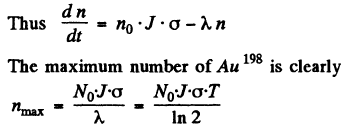(a) Suppose N0 = no. of Au197 nuclei in the foil. Then the number of Au197 nuclei transformed in time t is

For this to equal ηN0 , we must have

(b) Rate of formation of the Au198 nuclei is N0 • J • σ per sec and rate of decay is λn, where n is the number of Au198 at any instant.

because if n is smaller,  and n increase further and if n is larger
and n increase further and if n is larger  and n will decrease. (Actually nmax is approached steadily as t →∞) Substitution gives using
and n will decrease. (Actually nmax is approached steadily as t →∞) Substitution gives using
